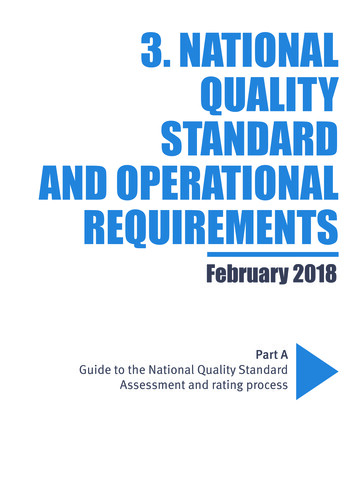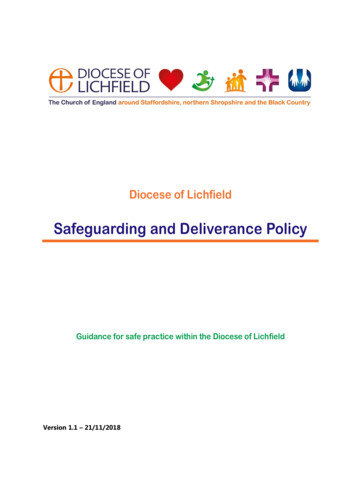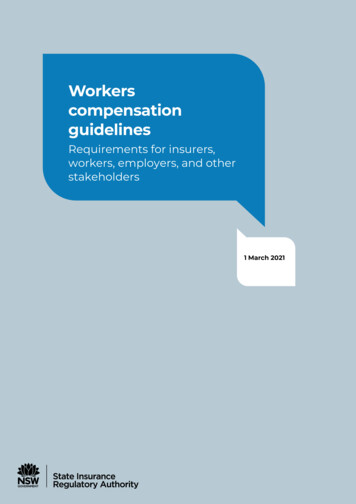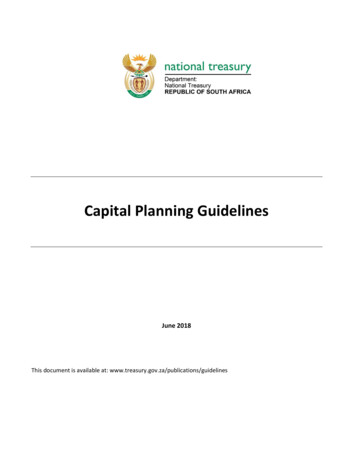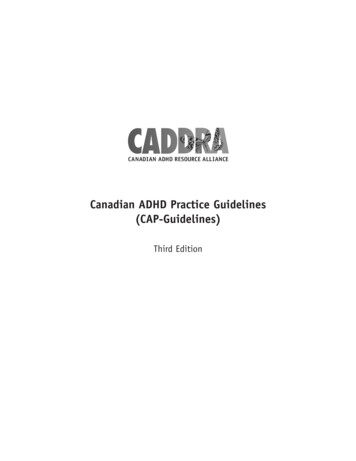
Transcription
National Standard 1 GuidelinesSummary of 2016 RevisionsHMS Advisory PanelMay 9, 2017
Outline1. Background2. Rulemaking Objectives3. Provisions of Interest4. Questions
National Standard 1 (NS1) National Standard 1 is a critical component to theMSA’s success Requires that U.S. fisheries management:A. Prevent overfishingB. Achieve optimum yield NS1 guidelines provide guidance on how to achieverequirements (A) and (B)U.S. Department of Commerce National Oceanic and Atmospheric Administration NOAA Fisheries Page 3
Basis for Action 2007 MSA Reauthorization Introduced annual catch limits (ACLs) and accountabilitymeasures (AMs) requirements ACLs and AMs transformed federal fisheriesU.S. Department of Commerce National Oceanic and Atmospheric Administration NOAA Fisheries Page 4
2016 Revisions to the NS1 GuidelinesObjectives:1. Improve & streamline guidelines2. Address experience gained duringimplementation of ACLs & AMs3. Provide flexibility to address management issueswithin current statutory limitsDo not require revision of current FMPsU.S. Department of Commerce National Oceanic and Atmospheric Administration NOAA Fisheries Page 5
ACL FrameworkMaximum amount of catch withoutoverfishingOverfishing LimitCatch in Tons of a StockIncreasingAcceptable Biological CatchYear 1Addresses scientific uncertaintyand Council’s risk policyAnnual Catch LimitTriggers AMs; often ABCAnnual Catch TargetOptional, addresses managementuncertaintyMSA contains: Exceptions for international stocks and stocks with annual life cycleU.S. Department of Commerce National Oceanic and Atmospheric Administration NOAA Fisheries Page 6
Features of NS1 Final Rule1. Increasing stability to fisheries2. Increasing flexibility in rebuilding plans3. Determining adequate progress in rebuilding4. Determining which stocks require federal management5. Clarifying OY and FMP objectivesU.S. Department of Commerce National Oceanic and Atmospheric Administration NOAA Fisheries Page 7
Increasing stability to fisheriesA. Carrying over unused quota into the next yearB. Multi-year overfishing status determinationsU.S. Department of Commerce National Oceanic and Atmospheric Administration NOAA Fisheries Page 8
Increasing stability to fisheriesA. Carrying over unused quota into the next yearB. Multi-year overfishing status determinationsU.S. Department of Commerce National Oceanic and Atmospheric Administration NOAA Fisheries Page 9
Carry-Over Approach #1: Utilizing ACL bufferU.S. Department of Commerce National Oceanic and Atmospheric Administration NOAA Fisheries Page 10
Carry-Over Approach #2: ABC Control RuleConsider the stock’s condition & the reason for the underage prior to carryingoverU.S. Department of Commerce National Oceanic and Atmospheric Administration NOAA Fisheries Page 11
Increasing stability to fisheriesA. Carrying over unused quota into the next yearB. Multi-year overfishing status determinationsU.S. Department of Commerce National Oceanic and Atmospheric Administration NOAA Fisheries Page 12
Multi-year overfishing status determinations Agency reports on stock status annually Last year of data is often the most uncertain2.5F / MFMT ear20082009201020112012limitU.S. Department of Commerce National Oceanic and Atmospheric Administration NOAA Fisheries Page 13
Multi-year overfishing status determinations When data is uncertain, overfishing status determinations may be basedon a 3 year average Increases reporting consistency2.5F / MFMT 20112012OverfishinglimitF2010-2012/FMSYU.S. Department of Commerce National Oceanic and Atmospheric Administration NOAA Fisheries Page 14
Multi-year overfishing status determinations Provision does not allow: setting future annual catchlimits at levels that do not prevent overfishing800Catch600400Catch20002008Overfishing LimitFuture catchlimit200920102011201220132014201520162017U.S. Department of Commerce National Oceanic and Atmospheric Administration NOAA Fisheries Page 15
Features of NS1 Final Rule1. Increasing stability to fisheries2. Increasing flexibility in rebuilding plans3. Determining adequate progress in rebuilding4. Determining which stocks require federal management5. Clarifying OY and FMP objectivesU.S. Department of Commerce National Oceanic and Atmospheric Administration NOAA Fisheries Page 16
Increasing flexibility in rebuilding plansCalculating Tmax for stocks that require 10 years to rebuild2009 Guidelines provided 1 method:1) Tmin generation time2016 Guidelines provides 3 methods:1) Tmin generation time2) Tmin*23) Time needed to rebuild to BMSY when fished at 75% of MFMTU.S. Department of Commerce National Oceanic and Atmospheric Administration NOAA Fisheries Page 17
Features of NS1 Final Rule1. Increasing stability to fisheries2. Increasing flexibility in rebuilding plans3. Determining adequate progress in rebuilding4. Determining which stocks require federal management5. Clarifying OY and FMP objectivesU.S. Department of Commerce National Oceanic and Atmospheric Administration NOAA Fisheries Page 18
Determining adequate progress in rebuildingAdequate progress is not being made if:1. F Frebuild or catch ACL, and AMs are not effective,or2. New and unexpected information significantly changesrebuilding expectationsU.S. Department of Commerce National Oceanic and Atmospheric Administration NOAA Fisheries Page 19
Features of NS1 Final Rule1. Increasing stability to fisheries2. Increasing flexibility in rebuilding plans3. Determining adequate progress in rebuilding4. Determining which stocks require federal management5. Clarifying OY and FMP objectivesU.S. Department of Commerce National Oceanic and Atmospheric Administration NOAA Fisheries Page 20
Determining which stocks require federal managementU.S. Department of Commerce National Oceanic and Atmospheric Administration NOAA Fisheries Page 21
Determining which stocks require federal management10 Factors To Consider:1.2.3.4.5.6.7.The stock is an important component of the marine environment.The stock is caught by the fishery.Whether an FMP can improve or maintain the condition of the stock.The stock is a target of a fishery.The stock is important to commercial, recreational, or subsistence users.The fishery is important to the Nation or to the regional economy.The need to resolve competing interests and conflicts among user groups and whether anFMP can further that resolution.8. The economic condition of a fishery and whether an FMP can produce more efficientutilization.9. The needs of a developing fishery, and whether an FMP can foster orderly growth.10. The extent to which the fishery is already adequately managed by states, bystate/Federal programs, by Federal regulations pursuant to other FMPs or internationalcommissions, or by industry self-regulation, consistent with the requirements of theMagnuson-Stevens Act and other applicable law.U.S. Department of Commerce National Oceanic and Atmospheric Administration NOAA Fisheries Page 22
Features of NS1 Final Rule1. Increasing stability to fisheries2. Increasing flexibility in rebuilding plans3. Determining adequate progress in rebuilding4. Determining which stocks require federal management5. Clarifying OY and FMP objectivesU.S. Department of Commerce National Oceanic and Atmospheric Administration NOAA Fisheries Page 23
Clarifying OY Relationship between OY and ACL Qualitative analyses of economic, ecological, andsocial factors are permissibleU.S. Department of Commerce National Oceanic and Atmospheric Administration NOAA Fisheries Page 24
FMP Objectives Managers should reassess the FMP’s managementobjectives on a regular basis.U.S. Department of Commerce National Oceanic and Atmospheric Administration NOAA Fisheries Page 25
The updated NS1 Guidelines: Provide tools to increase stability and flexibility withinfisheries management Do not establish any new requirements to revisemanagement plansU.S. Department of Commerce National Oceanic and Atmospheric Administration NOAA Fisheries Page 26
Next Steps Provide responses to NS1 questions posed bythe CCC Technical guidance as appropriateU.S. Department of Commerce National Oceanic and Atmospheric Administration NOAA Fisheries Page 27
Questions?U.S. Department of Commerce National Oceanic and Atmospheric Administration NOAA Fisheries Page 28
U.S. Federal Fisheries ManagementConservation success 40 stocks rebuilt Number of stocks that are not overfished/subject tooverfishing are at historic lowsEconomic success Commercial & recreational industrygenerates 210 billion Supports 1.8 million jobs
Phasing-in changes to catch levelsMust prevent overfishing each 100ABC(1/3 0172018U.S. Department of Commerce National Oceanic and Atmospheric Administration NOAA Fisheries Page 31
Increasing flexibility in rebuilding plansDiscontinuing rebuilding plans10.90.80.7B/Bmsy0.60.50.4Overfished threshold0.3B/Bmsy (2010)0.2B/Bmsy 20152016U.S. Department of Commerce National Oceanic and Atmospheric Administration NOAA Fisheries Page 32
Advancing EBFMExample: Aggregate MSYAggregate MSYfor a FisheryOY for a FisheryStock 1ACL andSDCStock 4ACL andSDCStock 5ACL andSDCStock 2ACL andSDCStock 6ACL andSDCStock 3ACL andSDCStock 7ACL andSDCU.S. Department of Commerce National Oceanic and Atmospheric Administration NOAA Fisheries Page 33
National Standard 1 (NS1) National Standard 1 is a critical component to the MSA's success Requires that U.S. fisheries management: A. Prevent overfishing B. Achieve optimum yield NS1 guidelines provide guidance on how to achieve requirements (A) and (B)
